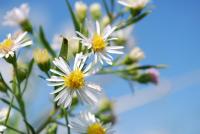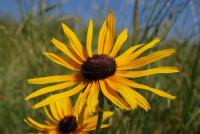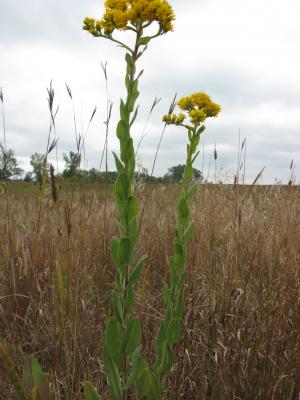Toolbox Home
Diversity
- It is recommended to include at least three flowering species in each bloom period (spring, summer, fall) for projects so there is a continuous food source throughout the seasons.
- In large conservation plantings separate pollinator plots/zones may be planted as high diversity areas (.3-2 acres). These plots/zones should include at least 15 species and have a high percentage of forbs (greater than 50% by seed count). See the list of Pilot State Seed Mixes for pollinator plot mixes for different parts of Minnesota.
- Clump-forming grasses are important to provide nesting sites and to provide fuel for prescribed burning but are generally kept between 3 and 5 pounds per acre in pollinator mixes.
- Shorter grasses such as little bluestem, side oats grama, and prairie dropseed (species that commonly grow in dry prairies) create less shade than taller grasses and allow forbs to grow effectively. Species should be selected that can persist in the soil and hydrology conditions of the site.
Layout
- It is helpful to plant forbs in masses to make them easier for pollinators to find and to increase foraging efficiency. This is a good strategy for smaller stormwater plantings and native gardens as it also creates a sense of order for projects.
- For urban projects it is useful to use "cues for care" along with native plantings to create order; such as edging, walls, fences, walkways, etc..
- Including a wide range of flower colors and shape will benefit a variety of pollinator species.
- Flowering trees and shrubs can also be important sources of pollen and nectar for pollinators, particularly early in the spring.
Insects
- When possible, plant species that can support specific insects that have specific needs for different geographic areas. (i.e., lupine for Karner blue butterfies, milkweed for monarchs, mints and goldenrods for Rusty-patch bumblebee).
- Plants and plant communities native to a specific area will provide the most benefit to local pollinators.
Seed Mixes/Plants
- The NRCS 643 Practice Standard is used to provide specifications for most BWSR restoration projects in combination with the BWSR’s Native Vegetation Establishment and Enhancement Guidelines, which provide guidance about diversity and seed/plant sources for projects.
- Private seed vendors often have pollinator mixes that can be used for projects. (Seed & Plant sources)
- State seed mixes can also be used for pollinator habitat and will be going through additional revision to maximize benefits over time.
- It is important to only use seed mixes/packets that have regionally adapted and appropriate species. See the fact sheet titled What You Can Do To Help Pollinators.pdf for more information.
Selecting Plants and Seed Mixes
- Spring
Alumroot
American Basswood
Broad-leaf Arrowhead
Blanketflower
Bloodroot^
Buttercups
Columbine^
Common Strawberry
Dutchman's Breeches*^
Field Blue-eyed Grass
Golden Alexander*
Hoary Puccoon
Juneberries*
Large Flowered Bellwort^
Long-headed Thimbleweed
Large-Flowered Penstemon*
Prairie Milk Vetch
Prairie Phlox
Prairie Smoke
Rue Anemone*
Solomon's Seal
Spiderwort
Trillium
Virginia Bluebells^
White Baneberry^
Wild Lupine*
Wild Petunia
Willows (pdf) (Salix sp.)
- Summer
Angelica
Bedstaws (Galium sp.)
Blazing Stars* (Liatris sp.)
Blue Lobelia*
Blue Vervain
Bottle Gentian
Bush Clovers
Canada Tick Trefoil
Coreopsis*
Cow Parsnip
Culver's Root*
Cup Plant*
Dogbane*
Evening Primrose
False Sunflower*
Harebell*
Hedge Nettle
Hoary Vervain*
Ironweed
Jewelweed
Large-leaved Aster^
Milkweeds* (Asclepias sp.)
Narrow Leaf Coneflower*
Native Loosestrifes
New Jersey Tea
Obedient Plant*
Partridge Pea
Prairie Cinquefoil
Purple Prairie Clover*
Prairie Turnip
Prairie Wild Onion
Raspberries (pdf)/Blackberries*
Smooth Sumac
Spotted Bee Balm
Snowberry/Wolfberry
Turtlehead
Virginia Mountain Mint*
Waterlilies
Wild Bergamot
Wild Iris
Wild Quinine*
Yarrow
- Fall
American Vetch
Annual Sunflower*
Boneset*
Bugleweeds (Lycopus sp.)
Checkweeds
Gentians*
Maximilian's Sunflower*
Showy Goldenrod*
Sneezeweed*
Stiff Goldenrod*
Virginia Mountain Mint*
White Snakeroot^
Zig Zag Goldenrod*^
*High Value for Pollinator Species
^Shade Tolerant Species





